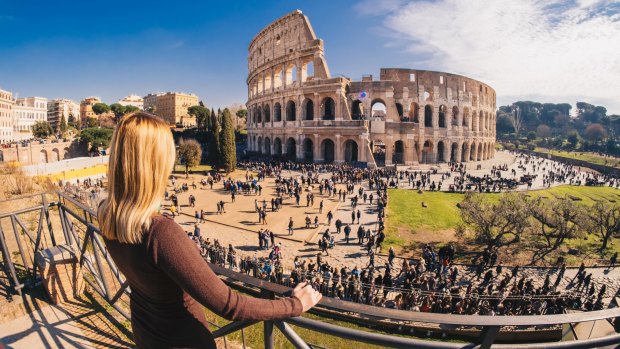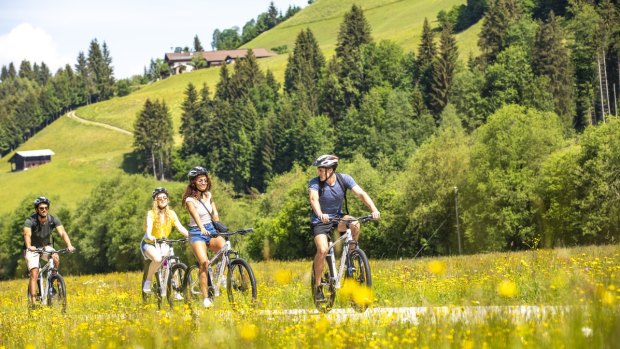This was published 4 years ago
The end of sight-seeing trips: Travellers now seek experiences over sights
By Ben Groundwater

Just seeing the sights no longer cuts it for travellers.Credit: Shutterstock
It's been a slow change, so you probably haven't noticed. You may not have twigged to the subtle difference in the brochures and the websites you're perusing, in the way travel is sold, and also in the way people are talking about their holidays now, the things they're boasting about seeing and doing.
Sight-seeing is out. The traditional idea of a trip away, of going from place to place and checking off various big-ticket items, of doing the Colosseum and the Eiffel Tower and the statue of David and then going home, is finished.
People still want to see those things, but they want more now, too. They want immersion. They want interaction. They want, essentially, experiences.

Tour company Contiki is now more focused on offering experiences.
That's what travel is about now. Even in this age of Insta-fame and selfie-taking and influencers lounging around on beaches, what's most important to travellers is having experiences in foreign places that feel authentic, diving deeper into the culture, interacting with local people and doing local things.
You just have to check out what the travel companies are promoting to realise that. Take Contiki, for instance: once the kings of "stop and snap" European travel, the company now lists exactly how many "experiences" you'll have on each its trips. Those experiences are more than just seeing a sight. They're things like eating macarons under the Eiffel Tower, or cycling around Edam on a cheese tour.
And this new style appeals to all budgets and age groups. Touring companies aimed at retirees are spruiking experiences. Hardcore overlanders in Africa and South America are all about local immersion.
Even Airbnb, the world's largest provider of travel accommodation, has extended its business model to include the idea of experiences, to offer its clients the chance to do something local and unique with people who live in their destination of choice, rather than just sleep in an apartment. Those experiences are things like learning to paint, hearing about local architecture from an expert, taking a surf lesson with a local.
Sight-seeing trips are finished. Even the traditional guidebooks have twigged to it. Go to Lonely Planet's website, plug in a destination and the first thing you'll see listed is "top experiences". Some of those experiences, admittedly, are quite static, and involve little more than visiting a famous sight, but others are things like "savour a steak dinner" in Argentina, or "see ballet at the Bolshoi" in Russia.
This is a growing phenomenon, clearly. In 2018, according to TripAdvisor, 67 per cent more travellers chose to book an experiential, outdoor activity than in 2017. The popularity of cooking classes and other workshops rose by 61 per cent. The best travel experience in the world in 2018 wasn't a visit to the Louvre or a trip to the Statue of Liberty, it was a cooking class in Tuscany.
So why the change? Essentially, people are travelling more now – as mentioned last week, travel has never been more affordable or accessible – they're becoming more familiar with being in a foreign country and they want to take it further. They want something extra.
They want the famous photos, for sure. They want to go to all of the places they've seen on Instagram and get a similar snap. But they want to go home with intangibles, too: knowledge. Skills. Friends.
There's an old saying that writers of fiction go by: "Show, don't tell". The idea being that stories and ideas are so much more forceful and memorable when the reader has to play an active part in their dissemination, when they have to think or participate to understand what's going on.
That's how you achieve an emotional response in a reader, and it's how you achieve an emotional response in a traveller, too. It's how you establish a real connection to a place or a people. It's immersion and interaction: something so much more powerful than standing in front of a building and taking a photo.
Show, don't tell. Don't tell me about the tango in Buenos Aires – show me how to do it. Don't tell me about pasta in Tuscany – show me how to make it. Don't tell me about wine in Bordeaux – show me how to taste it.
That's emotion, but it's also connection. You feel like you're really part of a destination when you travel like this. You're not standing on the outside looking in. You're in.
You don't want someone to tell you about a city, or a tradition, or a ritual or a passion. You want them to make you part of it. You want to do it and feel it and remember it.
That's powerful, meaningful, memorable travel. Sightseeing can never compare.
Have you become an experiential traveller? What are some of the best experiences you've had around the world? How do they differ from the traditional sight-seeing style of travel?
Sign up for the Traveller newsletter
The latest travel news, tips and inspiration delivered to your inbox. Sign up now.